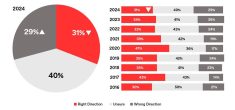David Drozd
Recent volatile price action is similar to that seen in the early 1970s when markets realigned into a new higher trading range.
Examining these more than three-decade-old patterns can reveal clues about future price direction; history often repeats itself because human nature never changes.
If history should repeat, similar to trading patterns seen in the accompanying chart from 35 years ago, current grain prices could be near the bottom of a new higher trading range, similar to (2) or (4) on the chart. If so, grain and energy prices could rally back up quicker and further than most expect.
Read Also

Mazergroup’s Bob Mazer dies
Mazergroup’s Bob Mazer, who helped grow his family’s company into a string of farm equipment dealerships and the main dealer for New Holland machinery in Saskatchewan and Manitoba, died July 6 from cancer.
As the forces influencing grain prices continue to evolve, including the political, economic, financial, as well as the flow of money in and out of the markets, two important factors will always remain constant: fear and greed.
No one watching markets over the past six months needs to be reminded that fear and greed have definitely influenced events, and are often responsible for causing folks to make poor marketing decisions.
Market psychology
As a market rallies to new highs, it is common for investors and farmers to become complacent. Folks are happy. The news is bullish and there is optimism for higher prices. Life is good, and folks are lulled into a false sense of security that gives way to a tendency to watch and see where the market will go. Caution is thrown to the wind, as folks become concerned about selling too soon. Some even hope to sell everything at the top of the market, in order to earn bragging rights at the coffee shop. This is the greed factor.
Farmers are the most optimistic group you’ll ever meet. This admirable quality, however, can lead to hesitation and procrastination when it comes to deciding when to sell their grain, especially when one considers the news is always the most bullish at the top.
As a market declines, the euphoria experienced at the top is quickly forgotten. Now, there is concern. Folks are no longer happy.
The news is bearish, and there is the fear of prices falling even further. Life is no longer good as folks begin thinking they coulda, woulda and shoulda sold at the highs. They wonder if the market will ever turn back up? Many will panic and sell at the low because the news is always the most bearish at the bottom. This is the fear factor.
Having a sound marketing plan is key to avoid being caught up in the hysteria that greed and fear bring to the market place.
Successful farmers know their cost of production, their cash flow requirements and their breakeven price per bushel. Above all, they maintain the discipline to capitalize on marketing opportunities and make sales accordingly.
Today, the global economy is uncertain, but one thing we know for sure is that an increasing world population still requires food and transportation. Despite having grown five of the largest coarse grain crops in the past five years, world stocks-to-usage ratios, which are approaching 35-year-lows, continue to erode as consumption outstrips production.
Considering the fast-growing and increasingly affluent Asian population, determined to improve its diet, along with an attractive U. S. dollar, cheap grain prices and rock-bottom ocean freight rates – it’s no wonder that China has decided to import U. S. soybeans instead of consuming its own.
With Warren Buffet increasing his ownership in great companies and China buying U. S. soybeans at 50 per cent off, is there a lesson to be learned? Maybe it’s that if two of the shrewdest traders in the world are stocking up on bargains, how long will it be until others follow their lead?
Join me online at www.agchieve.ca/cooperator/for an audiovisual presentation about this article and chart.
David Drozd is president and senior market analyst for Winnipeg-based Ag-Chieve Corporation. The opinions expressed are those of the writer and are solely intended to assist readers with a better understanding of technical analysis in the markets influencing agriculture. The information contained herein is deemed to be from sources that are reliable, but its accuracy cannot be guaranteed. Visit us online at www.ag-chieve.ca/cooperator/for more educational tools and ideas about grain marketing, or call toll-free 1-888-274-3138.


















